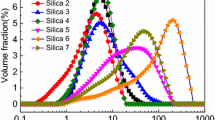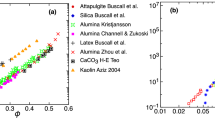Abstract
The effect of low-frequency conditioning on the particle size distribution of ethanol-precipitated human albumin protein has been examined. Laboratory-scale data has been extrapolated to the pilot-plant scale recovery of conditioned precipitates by high-speed centrifugation.
Data comparing batch ageing, low-frequency and static mixer conditioning is presented together with data exploring the relationship between pretreatment and the effectiveness of conditioning. Conditioning systems appear to be satisfactorily described in terms of the levels of mixing produced and the associated mechanisms of aggregation and breakage of large aggregates. Observed changes in size-distribution properties due to conditioning are seen to be translated into improved centrifugal recovery. The extent of pretreatment of the material to be conditioned is critical to the efficiency of the conditioning processes.
Similar content being viewed by others
Abbreviations
- CRX :
-
conditioning ratio a x% oversize
- d m:
-
amplitude of displacement
- DX μm:
-
volumetric oversize diameter of aggregate where x=% oversize
- f s—1 :
-
frequency of oscillation
- G s−1 :
-
mean shear rate
- k, k 1 :
-
rate constants describing aggregation and breakage respectively, Eqs. (1) and (2)
- N f m−3 :
-
number concentration of fine-sized particles
- N L m−3 :
-
number concentration of large-size particles
- Re f :
-
flow Reynolds number
- t s:
-
time
- V 0 m/s:
-
peak velocity of flow
- W m:
-
channel half-width
- σ :
-
response factor (see [5])
- η m2 s−1 :
-
fluid kinematic viscosity
- μ Ns/m2 :
-
fluid viscosity
- φ V :
-
volume fraction of precipitate particles
References
Hoare, M.; Narendranathan, T. J.; Flint, J. R.; Heywood-Waddington, D.; Bell, D. J.; Dunnill, P.: Disruption of potein precipitates during shear in Coutte flow and in pumps. Ind. Eng. Chem. Fundam., 21 (1982) 402–406
Mannweiler, K.; Titchener-Hooker, N. J.; Hoare, M.: Biochemical engineering improvements in the centrifugal recovery of biological particles. IChemE Symposium: Advances in Biochemical Engineering, Newcastle (1989) 105–117
Bell, D. J.; Dunnill, P.: The influence of precipitation reactor configuration on the centrifugal recovery of isoelectric soya protein precipitate. Biotechnol. Bioeng. 24 (1982) 2319–2336
Hoare, M.; Titchener-Hooker, N. J.; Foster, P. R.: Improvement in separation characteristics of protein precipitates by acoustic conditioning. Biotechnol. Bioeng. 29 (1987) 24–32
Titchener-Hooker, N. J.; Hoare, M.; McIntosh, R. V.; Foster, P. R.: The effect of fluid jet mixing on protein precipitate growth during low-frequency conditioning. Chem. Eng. Sci. 47 (1) (1992) 75–86
Titchener-Hooker, N. J.; McIntosh, R. V.: Enhancement of protein precipitate strength and density by low-frequency conditioning. Accepted for publication in Bioprocessing Eng. (1992)
Virkar, P. D.; Hoare, M.; Chan, M. Y. Y.; Dunnill, P.: Kinetics of the acid precipitation of soya protein in a continuous-flow tubular reactor. Biotechnol. Bioeng. 24 (1982) 871–887
Schubert, P. F.; Finn, R. K.: Alcohol precipitation of proteins — the relationship of denaturation and precipitation for catalase. Biotechnol. Bioeng. 23 (1981) 2569–2590
Conn, E. J.; Strong, L. E.; Hughes, Jnr. W. L.; Mulford, D. J.; Ashworth, J. N.; Melin, M.; Taylor, H. L.: Precipitation and properties of serum and plasma proteins IV. A system for the separation into fractions of the protein and lipoprotein components of biological tissues and fluids. J. Am. Chem. Soc. 68 (1946) 459–475
Watt, J. G.: Automatically controlled continuous recovery of plasma protein fractions for clinical use. Vox Sang 18 (1970) 42–61
Foster, P. R.; Watt, J. G.: Methods of Plasma Protein Fractionation (J. M. Curling (Ed.). Academic Press, London (1980) 17–24
Bell, D. J.; Dunnill, P.: Mechanisms for the acoustic conditioning of protein precipitates to improve their separation by centrifugation. Biotechnol. Bioeng. 26 (1984) 691–698
Foster, P. R.: Proc. Int. Workshop Techn. Protein Separation Imp. Blood Plasma Fract. (H. Sandberg (Ed.)), USHDEW Publ. No. (NIH) (1978) 78–1422, p. 54–65 Washington D.C.
McIntosh, R. V.; Stenhouse, A.; Woolard, D.; Foster, P. R.: Improvements in the formation and separation of protein precipitates. IChemE Symp. Series No. 113 (1988) 77–91
Sobey, I. J.: Flow through furrowed channels. 1. Calculated flow patterns. J. Fluid. Mech. 96 (1) (1980) 1–26
Stephanoff, K. D.; Sobey, I. J.; Bellhouse, B. J.: Flow through channels. 2. Observed flow patterns. J. Fluid. Mech. 96 (1) (1980) 27
Bellhouse, B. J.; Bellhouse, F. H.; Curl, C. M.; Macmillan, T. I.; Gunning, A. I.; Spralt, E. M.; Macmurray, S. B.; Nelens, J. M.: High efficiency membrane oxygenator and pulsatile pumping system, and its application to animal trials. Trans. Am. Soc. Artif. Int. Organs, 19 (1973) 72–87
Bell, D. J.; Dunnill, P.: Shear disruption of soya protein precipitate particles and the effect of aging in a stirred tank. Biotechnol. Bioeng. 24 (1982) 1271–1285
Camp, T. R.: Flocculation and flocculation basins. Trans. Am. Soc. Civil Engineers 120 (1955) 1–16
Chan, M. M. Y.; Hoare, M.; Dunnill, P.: The kinetics of protein precipitation by different reagents. Biotechnol. Bioeng. 28 (1986) 387–393
Author information
Authors and Affiliations
Rights and permissions
About this article
Cite this article
Titchener-Hooker, N.J., McIntosh, R.V. A study of the effect of low-frequency conditioning on the size distribution properties and centrifugal recovery of human albumin precipitate. Bioprocess Engineering 8, 215–222 (1993). https://doi.org/10.1007/BF00369832
Received:
Issue Date:
DOI: https://doi.org/10.1007/BF00369832




